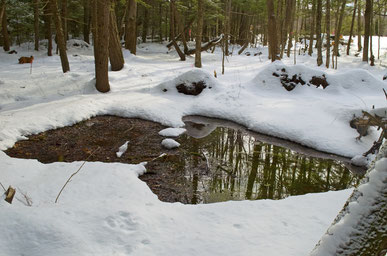The Forest Seeps of Distant Hill
"If you truly love Nature, you will find beauty everywhere."

We are lucky to have four
forest seeps on our 155-acres here at Distant Hill Gardens and Nature Trail. Forest seeps are very small wetlands, typically less than one acre in size, that occur around groundwater discharge areas in upland forests.

Soils in the seeps at Distant Hill Gardens remain saturated for most, if not all of the growing season and usually stay wet all winter. Surface waters of some seeps can percolate back into the ground through porous layers of sand or gravel, but at Distant Hill Gardens the surface water from the seeps run off to feed larger wetlands down hill.

Seep habitats are important for many animals and plants. This
is due to the fact that the water 'seeps' up to the surface from below the frost line at 45 to 50 degrees F. This keeps our three seeps from freezing during the winter. In
addition, these seeps are the first areas to green up in the spring due to the warm conditions.
Seeps as excellent food sources for Black bear in the spring and summer. Deer and moose seek seeps for food, water, and occasionally elements like calcium or sodium that may be present in the groundwater.
Northern dusky and two-lined salamanders prefer seep habitats, and they in turn attract predators such as skunk, raccoon, and river otter. Woodcock and robins depend on seeps for water and food after migrating and as a refuge after early spring snowstorms. Ruffed and spruce grouse are attracted to seeps for water during the winter and fresh plant food in the spring. Wild turkeys favor seeps in winter.
One of our seeps at Distant Hill Gardens also functions as a vernal pool and thus supports vernal pool breeding species
such as wood frogs and mole salamanders.

The composition of plant species varies among sites, but collectively seeps are diverse and support unique flora and fauna. Despite their small size, seeps add a distinct biological component to the matrix of upland forests. Many herbs, sedges, and mosses are restricted to forest seeps or other seepage wetlands.
Three of our seeps are Subacid Forest Seeps dominated by cinnamon fern, moss,
and marsh violets. One of the seeps at Distant Hill is a Circumneutral Hardwood Forest Seep with a higher pH and
richer soils. It supports ostrich fern and silvery spleen-wort, both rich site indicators.

Characteristic Seep Plant Species:
Seepage indicators:
Tiarella cordifolia (foamflower)
Carex scabrata (rough sedge)
Glyceria melicaria (northeastern manna-grass)
Circaea alpina (small enchanter’s nightshade)
Aster puniceus (purple-stemmed aster)
Chrysosplenium americanum (golden saxifrage)
Platanthera dilatata (tall white bog orchid)
Galium kamtschaticum (northern wild licorice)
Geum rivale (purple avens)
Mitella diphylla (two-leaved miterwort)
Listera cordata (heart-leaved twayblade)
Listera convallarioides (lily-leaved twayblade)
Cardamine pensylvanica (Pennsylvania bitter-cress)
Chelone glabra (white turtlehead)
Hydrocotyle americana (water pennywort)
Veratrum viride (false hellebore)
Carex leptalea (delicate sedge)
Carex disperma (two-seeded sedge)
Equisetum sylvaticum (wood horsetail)
Cypripedium pubescens (large yellow lady's-slipper)
Cystopteris bulbifera (bulblet bladder fern)
Sphagnum squarrosum and other bryophytes
Distant Hill was listed as one of the Top 10 Places to Visit in New Hampshire!
Friends of Distant Hill (dba Distant Hill Gardens and Nature Trail) is a nonprofit,
tax-exempt organization under Section 501(c)(3) of the U.S. Internal Revenue Code.
Donations are tax-deductible as allowed by law. Tax ID# 84-3765898
or send a check via Snail Mail to:
Distant Hill Gardens and Nature Trail, 507 March Hill Road, Walpole, NH 03608

